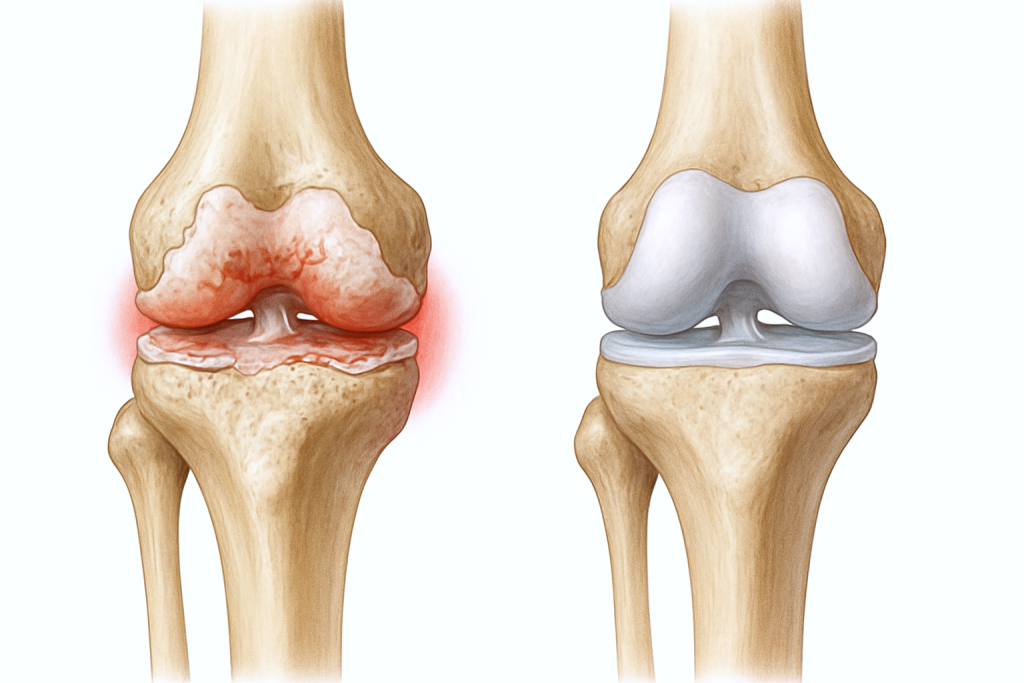What Is Osteoarthritis?
Osteoarthritis (OA) of the knee is a degenerative joint disease that occurs when the protective articular cartilage covering the ends of bones wears down over time. This cartilage normally allows for smooth, frictionless motion in the knee. As it deteriorates, the bones begin to rub directly against one another, leading to pain, swelling, and reduced mobility.
Unlike other inflammatory forms of arthritis (such as rheumatoid arthritis), osteoarthritis is considered a “wear-and-tear” condition. It is the most common form of arthritis affecting the knee joint.
Causes and Risk Factors
There is no single cause of knee osteoarthritis, but several factors increase risk:
- Age: Cartilage naturally wears with age.
- Joint Injury: Prior trauma (e.g., ligament or meniscal tears) can accelerate cartilage breakdown.
- Overuse or Heavy Activity: Jobs or sports involving repetitive motion or heavy lifting increase stress on the joint.
- Obesity: Excess weight increases pressure on the knee, especially the inner (medial) compartment.
- Malalignment: “Bow-legged” (varus) or “knock-kneed” (valgus) alignment places uneven load on the knee.
- Genetics: Family history of arthritis may predispose individuals to early degeneration.
- Previous Surgery: Partial meniscectomy or ligament reconstruction may alter joint mechanics.
Symptoms of Knee Osteoarthritis
Symptoms often develop gradually and may worsen over time. Common signs include:
- Persistent pain, especially during or after activity
- Swelling and stiffness, particularly after periods of rest
- Grinding or crunching sensation during movement (crepitus)
- Decreased flexibility or range of motion
- Locking or buckling of the knee
- Pain with weather changes (due to pressure sensitivity)
Diagnosis at Kerlan Jobe Institute
Our knee specialists begin with a thorough clinical evaluation, including your medical history, symptoms, and physical exam. To confirm diagnosis and assess severity, we use:
- X-rays: To detect joint space narrowing, bone spurs (osteophytes), and alignment issues
- MRI: Useful for evaluating cartilage wear, meniscal damage, and early joint changes
- Weight-Bearing Imaging: Helps us understand joint function under stress
Treatment Options for Knee Osteoarthritis
At Kerlan Jobe Institute, our goal is to relieve symptoms, slow progression, and help you stay active. We tailor treatment plans based on the stage of OA, your activity goals, and overall joint health.
Non-Surgical Treatments
- Lifestyle Modifications: Weight loss, activity modification, joint-friendly exercise
- Physical Therapy: Improves strength, flexibility, and joint stability
- NSAIDs: Oral or topical anti-inflammatory medications for pain relief
- Hyaluronic Acid Injections: Lubricate the joint to improve motion and reduce pain
- Corticosteroid Injections: Targeted anti-inflammatory relief
- Biologic Injections (PRP, stem cells): Support joint healing and may slow progression
Surgical Treatments
When conservative treatment fails to relieve symptoms, surgical options may be considered:
- Arthroscopic Debridement: Smoothing worn cartilage surfaces (typically for mild OA)
- Osteotomy: Bone realignment to offload damaged cartilage in younger, active patients
- Partial Knee Replacement (Unicompartmental): For damage limited to one part of the joint
- Total Knee Replacement: For advanced, widespread cartilage loss
Staging of Osteoarthritis
Osteoarthritis is often classified in four stages:
- Stage 1 – Minor: Little wear; no major pain or functional limitations
- Stage 2 – Mild: Early signs on X-ray; some stiffness and aching
- Stage 3 – Moderate: Noticeable joint space narrowing and cartilage loss; daily pain
- Stage 4 – Severe: Bone-on-bone contact; chronic pain, major loss of motion
Understanding your stage helps us guide appropriate treatment and long-term planning.
Long-Term Management and Support
While cartilage loss from osteoarthritis is not reversible, many patients manage symptoms effectively for years without surgery. Our team emphasizes early intervention, customized rehabilitation, and joint preservation strategies.
At Kerlan Jobe Institute, we’re committed to helping you maintain an active lifestyle, delay surgical intervention when possible, and ensure the highest level of care if surgery becomes necessary.

